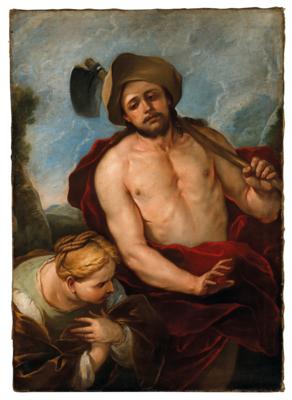Luca Giordano

(Naples 1634–1705)
Noli me tangere,
oil on canvas, 130 x 92 cm, framed
Provenance:
Private collection, Spain
Literature:
A. Pérez Sanchez, Más obras de Giordano en España, in: Ricerche sul ‘600 napoletano. Saggi e documenti 2000, Naples 2001, p. 129, illustrated p. 137, fig. 8 (as Luca Giordano)
We are grateful to Giuseppe Scavizzi for confirming the attribution on the basis of a photograph.
The present painting is an early work by Luca Giordano, painted around 1660–65. At this time Giordano was particularly influenced by Venetian painting and especially by the work of Titian. In the present work, these influences may be seen in the palette, rich in warm and bright colours and in the liveliness and freshness of the representation, both typically Venetian characteristics, as well as in the placement and modelling of the figures, a characteristic distinctive of Titian.
The present work depicts the subject of Noli me tangere as recorded by Saint John the Evangelist in the Bible (20:17). After His resurrection, Christ appears to Mary Magdalen after she found his sepulchre empty. Although she first mistook him as a gardener, on recognising Christ, she reached towards him, to which he responded, ‘touch me not [noli me tangere] for I am not yet ascended to my Father’. In the present composition, the figure of Christ, who dominates the canvas, is in fact portrayed with a hoe or scythe resting on his shoulder, while Mary Magdalen is crouched below him with an expression of disbelief and of passionate devotion towards him. Also, the wooden pole which Christ carries symbolises the cross.
Luca Giordano was one of the most versatile and well-travelled painters of the Italian Baroque. At the beginning of his career in Naples he was greatly influenced by Jusepe de Ribera, with whom he likely trained. In 1652, Giordano sojourned in Rome, where he was influenced by the Baroque art of Pietro da Cortona. In 1654, Giordano returned to Naples, where he experimented with a new style of Baroque art, characterised by lighter and more colourful works. Other influencers during this time were Peter Paul Rubens, Mattia Preti, Nicolas Poussin, and Guido Reni. In 1664/65 Giordano travelled to Venice. The following years, he spent travelling between Milan, Florence, Padua, Livorno, and Naples until moving to Madrid in 1692 King Charles II of Spain to move to Madrid and serve him as court painter. In Spain, Giordano developed a theatrical style which became highly successful and was in much demand.
Specialist: Mark MacDonnell
 Mark MacDonnell
Mark MacDonnell
+43 1 515 60 403
mark.macdonnell@dorotheum.at
19.12.2022 - 16:55
- Realized price: **
-
EUR 38,400.-
- Estimate:
-
EUR 30,000.- to EUR 40,000.-
- Starting bid:
-
EUR 30,000.-
Luca Giordano
(Naples 1634–1705)
Noli me tangere,
oil on canvas, 130 x 92 cm, framed
Provenance:
Private collection, Spain
Literature:
A. Pérez Sanchez, Más obras de Giordano en España, in: Ricerche sul ‘600 napoletano. Saggi e documenti 2000, Naples 2001, p. 129, illustrated p. 137, fig. 8 (as Luca Giordano)
We are grateful to Giuseppe Scavizzi for confirming the attribution on the basis of a photograph.
The present painting is an early work by Luca Giordano, painted around 1660–65. At this time Giordano was particularly influenced by Venetian painting and especially by the work of Titian. In the present work, these influences may be seen in the palette, rich in warm and bright colours and in the liveliness and freshness of the representation, both typically Venetian characteristics, as well as in the placement and modelling of the figures, a characteristic distinctive of Titian.
The present work depicts the subject of Noli me tangere as recorded by Saint John the Evangelist in the Bible (20:17). After His resurrection, Christ appears to Mary Magdalen after she found his sepulchre empty. Although she first mistook him as a gardener, on recognising Christ, she reached towards him, to which he responded, ‘touch me not [noli me tangere] for I am not yet ascended to my Father’. In the present composition, the figure of Christ, who dominates the canvas, is in fact portrayed with a hoe or scythe resting on his shoulder, while Mary Magdalen is crouched below him with an expression of disbelief and of passionate devotion towards him. Also, the wooden pole which Christ carries symbolises the cross.
Luca Giordano was one of the most versatile and well-travelled painters of the Italian Baroque. At the beginning of his career in Naples he was greatly influenced by Jusepe de Ribera, with whom he likely trained. In 1652, Giordano sojourned in Rome, where he was influenced by the Baroque art of Pietro da Cortona. In 1654, Giordano returned to Naples, where he experimented with a new style of Baroque art, characterised by lighter and more colourful works. Other influencers during this time were Peter Paul Rubens, Mattia Preti, Nicolas Poussin, and Guido Reni. In 1664/65 Giordano travelled to Venice. The following years, he spent travelling between Milan, Florence, Padua, Livorno, and Naples until moving to Madrid in 1692 King Charles II of Spain to move to Madrid and serve him as court painter. In Spain, Giordano developed a theatrical style which became highly successful and was in much demand.
Specialist: Mark MacDonnell
 Mark MacDonnell
Mark MacDonnell
+43 1 515 60 403
mark.macdonnell@dorotheum.at
|
Buyers hotline
Mon.-Fri.: 10.00am - 5.00pm
old.masters@dorotheum.at +43 1 515 60 403 |
| Auction: | Old Master Paintings |
| Auction type: | Online auction |
| Date: | 19.12.2022 - 16:55 |
| Location: | Vienna | Palais Dorotheum |
| Exhibition: | 13.12. - 19.12.2022 |
** Purchase price incl. charges and taxes
It is not possible to turn in online buying orders anymore. The auction is in preparation or has been executed already.
